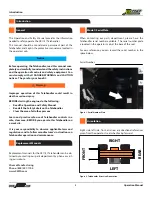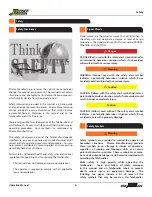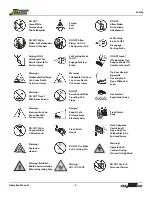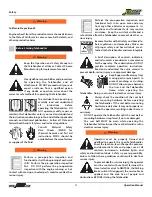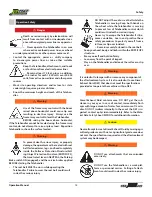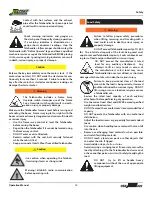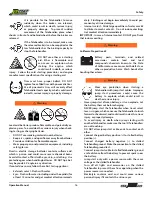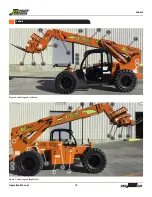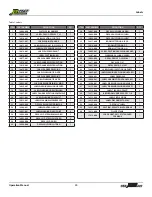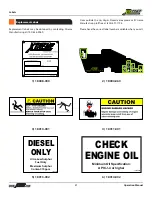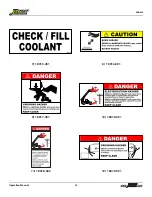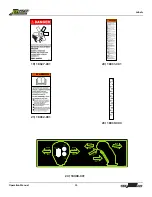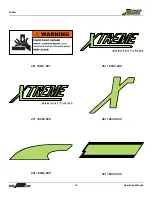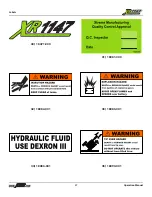
Operation Manual
13
Safety
NEVER allow passengers to
ride on the Telehandler. DO
NOT allow riders on the frame
or operator cab. Allowing
passengers to ride could result
in serious injury. The Telehandler is designed for the safety
of the operator only.
NEVER use crab or four wheel (4W) steering for
traveling at high speeds. Use only two wheel
(2W) steering for higher speed travel and slow
the Telehandler before turning. Rapid turning
while using crab or four wheel steering can
cause tip over which could result in death or serious injury.
DO NOT travel with an elevated boom.
Retract the boom fully. Lower the boom as
low as practical for proper visibility. Maintain
enough ground clearance for conditions.
Traveling with an elevated boom can cause
tip over, which could result in death or serious injury.
Allow for adequate clearance between the
attachment and other objects when turning.
The attachment extends beyond the front of
the Telehandler. The operator must be aware
of the maximum sweep of any attachment
being used to avoid hitting personnel and other objects in
the area and to prevent death, serious injury, or property
damage.
Warning
To prevent death, serious injury, or property
damage, make sure the Telehandler comes
to a complete stop before moving the travel
select lever. A sudden change in direction of
travel, while carrying a load, could reduce sta-
bility and/or cause the load to shift or fall.
DO NOT shift through multiple gears with a
single turn of the gear select lever. Allow the
engine speed to slow down before shifting to
the next lower gear. Improper use of the gear
select lever could cause transmission damage
or Telehandler tip over/roll over and result in death or seri-
ous injury.
Operate the Telehandler for maximum
stability. Unstable Telehandlers can tip over,
resulting in death, serious injury, or property
damage. Keep the Telehandler stable by
following these and other appropriate
guidelines:
•
Adjust speed for terrain and conditions.
•
Avoid obstacles by driving around them rather than
over them, when possible.
•
Start, stop, travel, steer, and brake smoothly.
•
Load, unload, and turn the Telehandler on level ground,
when possible.
•
Slow down for turns.
•
Slow down for rough, slippery, or soft terrain.
•
Use caution around steep slopes, creeks, gullies, ridges,
ditches, and ravines.
•
Stay away from soft edges that could collapse under
the Telehandler.
Become completely familiar with the
Telehandler before operating on slopes. The
Telehandler could overturn due to sudden
movement or while operating on a slope
resulting in death or serious injury.
DO NOT raise the boom while
operating on a slope. Rais-
ing the boom on a slope, even
without a load, will change the
center of gravity, could cause a
tip over, and result in death or
serious injury.
•
DO NOT turn on a steep slope.
•
DO NOT drive the Telehandler across slopes.
•
Always drive the Telehandler straight up and down a
slope (never drive diagonally up or down a slope).
•
Drive the Telehandler forward up a slope (front of Tele-
handler facing uphill).
•
Back the Telehandler down a slope when loaded (front
of Telehandler facing uphill).
Warning
Follow appropriate procedures to prevent
sudden changes in Telehandler speed that
could result in death or serious injury.
• Turn the gear select lever to the lowest
speed before descending a slope and before
loading or unloading a trailer.
•
DO NOT adjust the travel select lever while the
Telehandler is moving.
•
DO NOT coast downhill. Keep the travel select lever in
the appropriate position.
•
DO NOT exit the Telehandler without following proper
shut-down procedures.
Engine fuel is flammable and
can cause a fire or explosion
resulting in death or serious in-
jury. DO NOT smoke while refu-
eling and keep sparks and open
flames away from the Telehandler.





